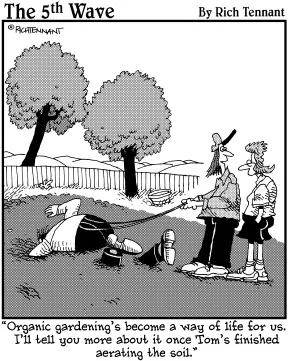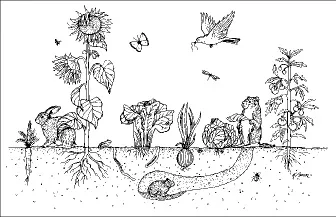Part I
Understanding the Basics of Organic Gardening
In this part . . .
Not sure what organic gardening is all about? Jump right into this part for an overview of what organic means. Chapter 1 introduces the foundations of organic gardening, along with basic techniques you’ll use whether you’re growing edibles, flowers, or lawn and landscape plants. Chapter 2 describes the benefits of gardening organically, as well as the risks to you and to the environment of using synthetic pesticides. If you need to justify your organic preferences to naysayers, you’ll have plenty to say after reading this chapter.
Evaluate your landscape conditions, such as sun exposure and soil moisture, with help from Chapter 3. And if you’ve ever wondered about microclimates and plant hardiness, this chapter is the place to turn. After gathering this information, you can begin planning your organic oasis; Chapter 3 also explains how to create a landscape map.
Chapter 1
Basic Techniques in Organic Gardening
In This Chapter
Understanding the philosophy behind organic gardening
Nurturing the soil
Diversifying your garden
Managing pests
Practicing conservation
Everyone agrees that organic gardening means avoiding synthetic fertilizers and pesticides. But the philosophy and practice of organic gardening go far beyond that simple concept. Growing organic food, flowers, and landscapes represents a commitment to a sustainable system of living in harmony with nature. For many people, organic gardening is a way of life. This chapter deals with the fundamentals of organic growing, including the philosophy behind organic gardening and the specific techniques that lead to success.
Defining Organic Gardening
The ways that people use — and misuse — soil, water, and air affect the lives and habitats of plants, insects, birds, fish, and animals, as well as humans. Organic gardening is all about preventing and treating problems in the least obtrusive, most nontoxic ways. Dedicated organic gardeners adopt methods that use cultural and natural biological processes to do the following:
Improve soil health and fertility: Organic gardeners nurture the soil ecosystem by adding organic matter, such as compost, and avoiding pesticides that can harm soil life. In turn, soil organisms consume and break down the organic matter, making the nutrients it contains available to plants.
Decrease erosion: Exposed soil is vulnerable to erosion by rain and wind. By covering soil with mulch, cover crops, or other protective materials, organic gardeners preserve the integrity of this precious resource.
Reduce pests and diseases: Organic gardeners minimize pest problems and reduce the need for pesticides by relying on cultural techniques, such as proper pruning, removing unhealthy plant material, and using row covers.
Encourage plant and animal diversity: Through diverse plantings and judicious use of pesticides — even organic ones — organic gardeners promote healthy ecosystems that invite beneficial organisms, including pollinators and predators of garden pests, to take up residence.
Organic gardeners take their cues from nature. Instead of relying on the spray schedules promoted by pesticide manufacturers, organic gardeners observe what’s going on in their gardens and intervene to prevent pest problems. When you see white butterflies fluttering around your garden, for example, you know it’s time to protect your cabbages, broccoli, and cauliflower from cabbage worm. Instead of sprinkling on a pesticide after the caterpillars hatch, you can cover the plants with a special fabric to prevent the butterflies from laying eggs in the first place.
Organic growers view their gardens as living ecosystems and work with nature to produce beautiful landscapes and healthy foods. No matter what plants you’re growing — vegetables, fruits, herbs, trees, flowers, grasses — the same basic techniques apply, as the following sections show.
Depleting soil fertility, damaging and polluting ecosystems, and consuming excess water threaten the future of Earth’s safe and abundant food supply. The ways that farmers and individual gardeners and homeowners choose to farm, garden, and maintain their landscapes make a difference in whether the land can continue to house, feed, and clothe us. Gardeners around the globe have adopted organic gardening techniques to help nurture the health of the Earth and all its inhabitants. (If you need more convincing that organic is the way to go, turn to Chapter 2.)
Building Soil
Just as a durable house needs a strong foundation, healthy plants require soil that can provide their roots with nutrients, water, and air. Few gardeners are blessed with perfect soil, and even if they were, keeping soil healthy and able to support plants is an ongoing process. Building and maintaining healthy soil is the single most important thing you can do to ensure the success of your garden and landscape plants.
Building soil means providing soil life — microbes, worms, fungi — with the materials and environment they need to do their jobs. Taking from the soil without giving anything back breaks the natural cycle. Harvesting crops, bagging lawn clippings, and raking fallen leaves removes organic material that’s ordinarily destined for the soil on which it falls. If the organic material isn’t replenished, soil health declines. Substituting synthetic chemical fertilizers for naturally occurring nutrients may feed plants, but it starves the soil.
Adding organic matter is the most common — and most important — part of building soil. Compost is a perfect source of organic matter; other sources include aged manures and crop residues. Maintaining proper soil pH (a measure of acidity/alkalinity) is also vital, because it affects soil life and the ability of plants to use nutrients.
Avoiding things that damage soil is just as important. Compaction from heavy foot or vehicle traffic and misapplied fertilizer and pesticides, for example, can harm the soil’s ability to support plant life. Part II tells you everything you need to know about your soil and how to improve it in an organically sound way.
Planting Wisely
Organic gardens strive to maintain healthy, balanced ecosystems. Because plants evolved over millennia to adapt to specific growing conditions, they thrive when those conditions are met. By choosing plants that match a garden site’s sun, shade, climate, soil type, and soil moisture, you’ll be well on your way to creating a healthy, thriving, pest-free landscape.
The first step in planting wisely is understanding your region’s climate, as well as your landscape’s particular attributes. Then you can effectively match plants to planting sites. You can find out more about evaluating your landscape in Chapter 3. For specific planting information and the lowdown on growing a wide variety of plants organically — vegetables, fruits, nuts, herbs, and flowers — go to the chapters in Part IV. You can also find information in that part on applying organic principles to lawn care.
The second step is ensuring that your garden cultivates stable plant and animal communities. In nature, plants and animals live in ecosystems — communities in which each part contributes to and affects the lives of the other parts. In a balanced ecosystem (see Figure 1-1), each plant and animal species has enough food, water, and habitat (place to live).
Figure 1-1: Plant and animal communities extend above and below ground.
In a balanced ecosystem, the predators have enough prey, and the prey have enough predators. When one part of an ecosystem dies out or becomes too scarce, the plants and animals that depend on its function in the environment get out of balance, too. If honeybees disappear, for example, the plants that need bees for flower pollination won’t be able to produce seeds. If predators such as ladybugs become scarce, the insects they normally prey on — aphids — will become so numerous that they will seriously injure or even kill the plants on which they feed.
Ensuring diversity of plant types
Organic gardeners mimic nature by encouraging diversity in their landscapes. Natural plant communities contain many species of trees, shrubs, and perennial and annual plants. This rich diversity helps each plant species survive in many...



